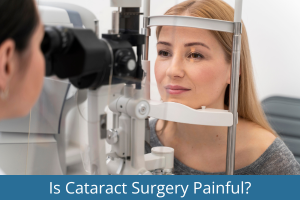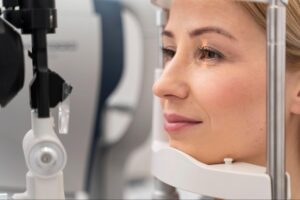Cataract Surgery in Children: Symptoms, Causes, Procedure, Risk and Recovery

Cataract surgery in children is a delicate procedure that can restore a child’s vision. Learn about the procedure, risks, recovery, and more in this blog post.
Cataract surgery is a common procedure that involves removing the cloudy lens of the eye and replacing it with an artificial lens. While it is more commonly associated with older adults, children can also develop cataracts, which can significantly impact their vision.
Cataract surgery in children is a delicate procedure that requires the expertise of a skilled paediatric ophthalmologist. In this blog, we will cover everything you need to know about symptoms, causes, procedure, risks, recovery, and more.
Symptoms of childhood cataracts
The symptoms of cataracts in childhood can vary depending on the severity and location of the cataract. In some cases, cataracts may be present at birth and can cause visual impairment or blindness if left untreated. Other times, cataracts may develop gradually over time and may not be noticed until they begin to affect vision.
Some common symptoms of cataracts in childhood include:
- Cloudy or blurry vision
- Reduced visual acuity or difficulty seeing in low light conditions
- Abnormal eye movements or “shaking” of the eyes (nystagmus)
- Sensitivity to light or glare
- Poor depth perception or difficulty with spatial awareness
- Strabismus (crossed or misaligned eyes)
- White or gray pupil, instead of the normal black pupil (“leukocoria)
If your child is experiencing any of these symptoms, it is important to schedule an appointment with an ophthalmologist as soon as possible for a comprehensive eye exam. Early diagnosis and treatment of cataracts in childhood can help prevent complications and improve long-term visual outcomes.
Causes of cataract in children
There are several possible causes of cataracts in children or infants, including:
- Congenital cataracts: These are cataracts that are present at birth and may be caused by genetic or developmental factors.
- Infections during pregnancy: Certain infections that a mother may contract during pregnancy, such as rubella, herpes, or toxoplasmosis, can increase the risk of cataracts in the infant.
- Injuries or trauma: Injuries to the eye or head can sometimes cause cataracts in children.
- Medical / genetic conditions: Certain medical conditions, such as Down syndrome, galactosemia, and Lowe syndrome, are associated with a higher risk of cataracts.
- Medications: Some medications, such as steroids (eye drops, creams or systemic steroids), can increase the risk of cataracts in children.
- Radiation exposure: Exposure to radiation, such as during cancer treatment, can increase the risk of cataracts.
- Unknown: In some cases, the cause of cataracts in children may be unknown.
It is important to note that while some risk factors for cataracts in children can be identified, many cases of childhood cataracts occur without an obvious cause. If your child is diagnosed with a cataract, your ophthalmologist will work with you to determine the most appropriate course of treatment based on the underlying cause, severity of the cataract, and other individual factors.
What Is Cataract Surgery in Children?
Understanding Cataracts
Before we dive into the details of cataract surgery in children, let’s first understand what cataracts are. Cataracts are a clouding of the eye’s natural lens, which is responsible for focusing light onto the retina at the back of the eye. This clouding can cause blurred or cloudy vision, and in some cases, can even lead to blindness. While cataracts are more commonly associated with older adults, children can also develop them for a variety of reasons, including genetic conditions, trauma, or infection.
Cataract Surgery in Children
Cataract surgery in children is a procedure that involves removing the cloudy lens of the eye, and often (but not always) replacing it with an artificial lens. The procedure is typically performed under general anaesthesia and takes around 30-60 minutes.
During the surgery, the paediatric ophthalmologist will make a small incision in the eye and use specialised instruments to break up and remove the cloudy lens. In all infants and some older children, the vitreous gel may also need to be removed carefully. The surgeon may then insert an artificial lens, which will help to restore the child’s vision.
Intraocular Lens Options
There are a variety of intraocular lens (IOL) options available for children undergoing cataract surgery. The type of lens chosen will depend on the child’s age, prescription, and other factors. Some of the most common types of IOLs used in children include:
- Monofocal IOLs: These lenses provide clear vision at a single distance. These are the most commonly used IOLs in children.
- Multi-focal IOLs: These lenses provide clear vision at multiple distances and can reduce the need for glasses or contacts. They may be considered in older children.
- Toric IOLs: These lenses are designed to correct astigmatism, which is a common refractive error that can cause blurred or distorted vision.
What Are the Risks of Cataract Surgery in Children?
Like any surgical procedure, cataract surgery in children does carry some risks. Some of the most common risks associated with the procedure include:
- Infection
- Bleeding
- Inflammation
- Retinal detachment
- Glaucoma (higher risk in younger infants)
It is important to note that while these risks are present, the overall risk of serious complications is relatively low, particularly when the surgery is performed by an experienced ophthalmologist.
What Is the Recovery Process Like?
The recovery process following cataract surgery in children is generally straightforward, but can take four or more weeks. Children will typically be able to go home the same day as the surgery, but they will need to avoid any strenuous activities or contact sports for a few weeks. They may also need to wear an eye patch or shield for a short period of time to protect the eye while it heals.
It is important to follow all post-operative instructions provided by the ophthalmologist to ensure the best possible outcome. This may include using eye drops to reduce inflammation and prevent infection, avoiding swimming or other activities that could introduce bacteria to the eye, and attending follow-up appointments to monitor healing and ensure that the new lens is functioning properly.
FAQ
Q: Can children of any age undergo cataract surgery?
A: Yes, children of any age can undergo cataract surgery. However, the timing of the surgery may vary depending on the individual case. In some cases, surgery may be recommended shortly after birth, while in other cases, it may be recommended when the child is older.
Q: Will my child need to wear glasses after cataract surgery?
A: It is likely that your child may still need to wear glasses after cataract surgery. However, the need for glasses may be reduced or eliminated depending on the type of intraocular lens used during the surgery.
Q: What can I expect during the surgery?
A: Cataract surgery in children is typically performed under general anaesthesia, so your child will be asleep during the procedure. The surgery itself typically takes around 30-60 minutes, and your child will be closely monitored by medical staff throughout the process.
Q: What are the potential complications of cataract surgery in children?
A: Complications of cataract surgery in children can include infection, inflammation, bleeding, retinal detachment, glaucoma and visual axis opacification (clouding of the artificial lens implant or capsule or vitreous gel). Your child’s ophthalmologist will take steps to minimise the risk of complications during and after surgery.
Q: What is the recovery time after cataract surgery in children?
A: The recovery time after cataract surgery in children can vary depending on the individual case and the surgical technique used. In general, most children can resume normal activities within one to two weeks after surgery, but it may take several weeks for vision to fully stabilise.
Conclusion
Cataract surgery in children is a delicate procedure that can restore vision and improve quality of life for young patients. While it does carry some risks, the overall risk of serious complications is relatively low when the surgery is performed by an experienced ophthalmologist. If you suspect that your child may have a cataract, it is important to seek medical attention as soon as possible to determine the best course of treatment.
Author Bio
Dr Parth Shah is a leading ophthalmologist in Canberra, specialising in cataract surgery and strabismus surgery. With extensive training and experience, he is renowned for his expertise in the field. Dr Shah is dedicated not only to performing successful surgeries but also to patient education. His compassionate approach, combined with technical proficiency, has earned him the trust and gratitude of countless patients. He is a true advocate for eye health and a trusted name in the Canberra ophthalmology community.
Other blogs related to Cataract

Is Cataract Surgery Painful?
Is Cataract Surgery Painful? Embarking on the journey towards better vision often raises concerns and questions, especially when it comes to surgical interventions. One such

Everything about Cataracts & Surgery: A detailed guide
Everything about Cataracts & Surgery: A detailed guide Cataracts are a common worry, especially as we get older. Imagine your eye’s natural lens gradually getting

Choosing Your Path to Cataract Surgery: Private or Public Practice
Choosing Your Path to Cataract Surgery: Private or Public Practice Deciding to have cataract surgery is a big deal, and opting to have the procedure

A Comprehensive Guide to Choosing the Right Intraocular Lens (IOL) for Cataract Surgery
A Comprehensive Guide to Choosing the Right Intraocular Lens (IOL) for Cataract Surgery Cataract surgery is a common and highly effective surgical procedure aimed at

Cataract Surgery in Patients with Diabetes: A Comprehensive Guide
Cataract Surgery in Patients with Diabetes: A Comprehensive Guide Cataracts are a common concern for many, but for individuals with diabetes, the journey through cataract

Driving With Cataract and After Cataract Surgery
Driving With Cataract and After Cataract Surgery Driving is a significant part of our lives, offering freedom and independence. But to drive safely, one’s vision

Cataract Surgery in Patients with Glaucoma
Cataract Surgery in Patients with Glaucoma Welcome to Clarity Eye Surgeons, where your eye health is our top priority. In this article, we will explore

The Complete Guide to Cataract Surgery Recovery: Timeline, Tips, and What to Expect
The Complete Guide to Cataract Surgery Recovery: Timeline, Tips, and What to Expect Cataract surgery is a common and highly effective surgical procedure aimed at

How to Choose a Cataract Surgeon: A Comprehensive Guide
How to Choose a Cataract Surgeon: A Comprehensive Guide When it comes to your eye health, selecting the right cataract surgeon is of utmost importance.

Cataract Surgery in Children: Symptoms, Causes, Procedure, Risk and Recovery
Cataract Surgery in Children: Symptoms, Causes, Procedure, Risk and Recovery Cataract surgery in children is a delicate procedure that can restore a child’s vision. Learn

One Response
Comments are closed.